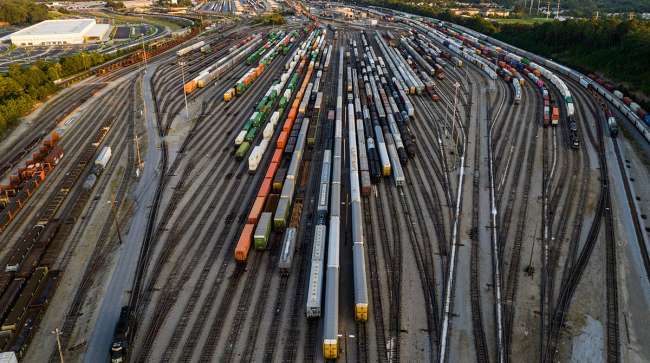STB Rule May Help Boost Competition for Railroad Shipments

[Stay on top of transportation news: Get TTNews in your inbox.]
OMAHA, Neb. — Companies that have plants and facilities served by only one railroad may soon be able to get a bid from another railroad if their current service is bad enough under a new rule that was proposed Sept. 7 to help boost competition.
The U.S. Surface Transportation Board announced the long-awaited rule that has been under consideration in some form at least since 2010. It aims to provide some relief to so-called captive shippers that only have a connection to one of the six giant freight railroads that deliver the vast majority of goods across North America.
Many companies have complained about poor railroad service over the past couple of years as the industry worked to recover from the depths of the pandemic. The railroads have acknowledged they cut their workforces too deep in 2020 and had a hard time hiring enough workers to handle all the shipments once demand returned because of the tight labor market and quality of life concerns over railroad work.
The railroads have made significant strides to improve service since the worst of the problems in the spring of 2022 as they hired more train crews. But labor unions have questioned whether the industry’s current lean operating model gives railroads enough capacity to handle all shipments safely even after the recent hiring.
New reform from the Surface Transportation Board will help address #FreightRail & #SupplyChain problems ➡️ https://t.co/znpHN3Ctcl pic.twitter.com/UnLzJUWoyJ — American Chemistry (@AmChemistry) September 7, 2023
The American Chemistry Council trade group that has been one of the leading advocates for the rules expressed some disappointment that the Surface Transportation Board moved away from an earlier proposal that would have been more proactive. It, however, welcomed regulators establishing some clear minimum service standards for railroads that never existed before and requiring railroads to report more details about their performance.
The hope is that the new service standards can help prevent the kind of severe supply chain challenges seen during the pandemic that had consumers scrambling to find toilet paper, cleaning wipes and other staples on their store shelves.
“I think this is really trying to get at how can you get the railroads to do better and head this off in the future so that it doesn’t get to a point that it becomes a problem for your everyday consumer,” American Chemistry Council spokesman Scott Jensen said.
STB Chairman Martin Oberman said it’s clear to him that increasing competition in this monolithic industry could do wonders for the countless companies that rely on railroads to deliver raw materials and finished products by giving railroads another incentive to improve service. The rail industry is dominated by six major Class I railroads with two in the west, two in the east and two in Canada, although one of those now also has tracks that cross the Midwest and connect to Mexico after a recent merger.
"Reciprocal switching would present railroads with a simple decision: provide better service to customers or risk losing business to a competitor...we welcome this progress and look forward to providing comments in the coming months." Our full statement: https://t.co/QfCLiASt7L — AFPM (@AFPMonline) September 7, 2023
“This rule will bring predictability to shippers and will provide Class I carriers with notice of what is expected of them if they want to hold on to their customers who might otherwise be eligible to obtain a switching order,” Oberman said.
Shippers would only be able to seek out a competing bid under this rule if their current railroad can’t deliver an average of 60% of its shipments on time over a 12-week period. Later that standard would increase to 70%.
Shippers would also be able to seek relief if the amount of time it takes the railroad to deliver a product significantly worsens or if the railroad fails to handle local deliveries on time on average.
Rob Benedict with the American Fuel and Petrochemical Manufacturers trade group said it’s a little disappointing that the rule would force companies to wait until service is bad to seek relief. But maybe the service standards in this rule will provide an incentive for railroads to do what they should have been doing all along: taking care of their customers, he said.
“Reciprocal switching would present railroads with a simple decision: Provide better service to customers or risk losing their business to a competitor,” Benedict said.
Getting the rule right is important because roughly 75% of refineries and petrochemical manufacturers are only served by a single railroad. Benedict said his group will be looking closely at the service standards established in the final rule to make sure the STB sets a high enough target to hold railroads accountable for providing good service.
The National Grain and Feed Association said this rule may finally “create some semblance of rail-to-rail competition” that will benefit all the shippers out there who have little bargaining power now because they are only on one railroad.
https://t.co/IDghOEinGO #roberbarons — Carl Smith (@SMARTTD_COSLB) September 7, 2023
The railroads have long opposed this idea because they worried about the congestion that might be created by having to either let a competing railroad come onto its network or hand off cars to the other railroad at an inconvenient location. Plus, the railroads said these rules could depress rates below market value at times.
Canadian regulators have long had similar rules that allow companies to hire other railroads to deliver their goods. And in Canada, companies are eligible to seek out service from a competitor as long as they are close enough to a connection with another railroad. The Canadian rules don’t require companies to prove they are getting poor service like the proposed new U.S. rules.
The head of the Association of American Railroads trade group, Ian Jefferies, said the railroads are studying the new rule to determine how big of an impact it might have on their operations. He said regulators should do a detailed cost-benefit analysis on this proposed rule to make sure it is effective.
Want more news? Listen to today's daily briefing above or go here for more info
“Any switching regulation must avoid upending the fundamental economics and operations of an industry critical to the national economy,” Jefferies said.
The nation’s largest rail union that represents conductors came out in support of the rule. Jeremy Ferguson, president of the Transportation Division of the International Association of Sheet Metal, Air, Rail and Transportation Workers union, said the hope is that encouraging more competition among the railroads will force them to run their companies better and improve the their treatment of workers.
“When monopolies are disrupted by capitalism, our country’s workers and the economy itself win, and win big,” Ferguson said.




